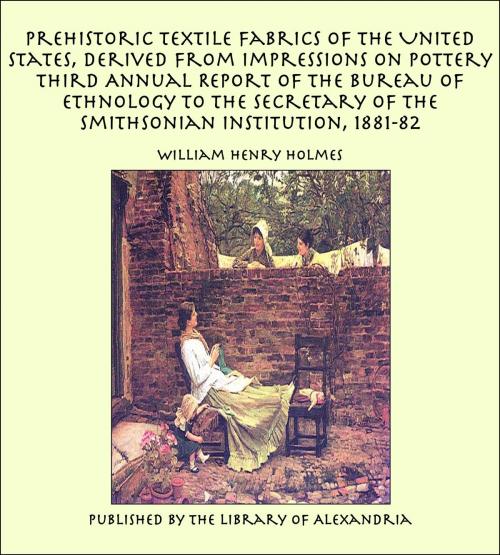Prehistoric Textile Fabrics of The United States, Derived From Impressions On Pottery Third Annual Report of the Bureau of Ethnology to the Secretary of the Smithsonian Institution, 1881-82
Nonfiction, Religion & Spirituality, New Age, History, Fiction & Literature| Author: | William Henry Holmes | ISBN: | 9781465547538 |
| Publisher: | Library of Alexandria | Publication: | March 8, 2015 |
| Imprint: | Language: | English |
| Author: | William Henry Holmes |
| ISBN: | 9781465547538 |
| Publisher: | Library of Alexandria |
| Publication: | March 8, 2015 |
| Imprint: | |
| Language: | English |
It is not my intention in this paper to make an exhaustive study of the art of weaving as practiced by the ancient peoples of this country. To do this would necessitate a very extended study of the materials used and of the methods of preparing them, as well as of the arts of spinning and weaving practiced by primitive peoples generally. This would be a very wide field, and one which I have no need of entering. I may state here, however, that the materials used by savages in weaving their simple fabrics consist generally of the fibre of bark, flax, hemp, nettles, and grasses, which is spun into thread of various sizes; or of splints of wood, twigs, roots, vines, porcupine quills, feathers, and a variety of animal tissues, either plaited or used in an untwisted state. The articles produced are mats, baskets, nets, bags, plain cloths, and entire garments, such as capes, hats, belts, and sandals. It has been noticed by a few authors that twisted or plaited cords, as well as a considerable variety of woven fabrics, have been used by primitive tribes in the manufacture and ornamentation of pottery. Impressions of these made in the soft clay are frequently preserved on very ancient ware, the original fabrics having long since crumbled to dust. It is to these that I propose calling attention, their restoration having been successfully accomplished in many hundreds of cases by taking impressions in clay from the ancient pottery. The perfect manner in which the fabric in all its details of plaiting, netting, and weaving can be brought out is a matter of astonishment; the cloth itself could hardly make all the particulars of its construction more manifest. The examples presented in the accompanying plate will be very instructive, as the fragment of pottery is given on the left, with its rather obscure intaglio impressions, and the clay cast on the right with the cords of the fabric in high relief. The great body of illustrations have been made in pen directly from the clay impressions, and, although details are more distinctly shown than in the specimens themselves, I believe that nothing is presented that cannot with ease be seen in the originals. Alongside of these restorations I have placed illustrations of fabrics from other primitive sources
It is not my intention in this paper to make an exhaustive study of the art of weaving as practiced by the ancient peoples of this country. To do this would necessitate a very extended study of the materials used and of the methods of preparing them, as well as of the arts of spinning and weaving practiced by primitive peoples generally. This would be a very wide field, and one which I have no need of entering. I may state here, however, that the materials used by savages in weaving their simple fabrics consist generally of the fibre of bark, flax, hemp, nettles, and grasses, which is spun into thread of various sizes; or of splints of wood, twigs, roots, vines, porcupine quills, feathers, and a variety of animal tissues, either plaited or used in an untwisted state. The articles produced are mats, baskets, nets, bags, plain cloths, and entire garments, such as capes, hats, belts, and sandals. It has been noticed by a few authors that twisted or plaited cords, as well as a considerable variety of woven fabrics, have been used by primitive tribes in the manufacture and ornamentation of pottery. Impressions of these made in the soft clay are frequently preserved on very ancient ware, the original fabrics having long since crumbled to dust. It is to these that I propose calling attention, their restoration having been successfully accomplished in many hundreds of cases by taking impressions in clay from the ancient pottery. The perfect manner in which the fabric in all its details of plaiting, netting, and weaving can be brought out is a matter of astonishment; the cloth itself could hardly make all the particulars of its construction more manifest. The examples presented in the accompanying plate will be very instructive, as the fragment of pottery is given on the left, with its rather obscure intaglio impressions, and the clay cast on the right with the cords of the fabric in high relief. The great body of illustrations have been made in pen directly from the clay impressions, and, although details are more distinctly shown than in the specimens themselves, I believe that nothing is presented that cannot with ease be seen in the originals. Alongside of these restorations I have placed illustrations of fabrics from other primitive sources















